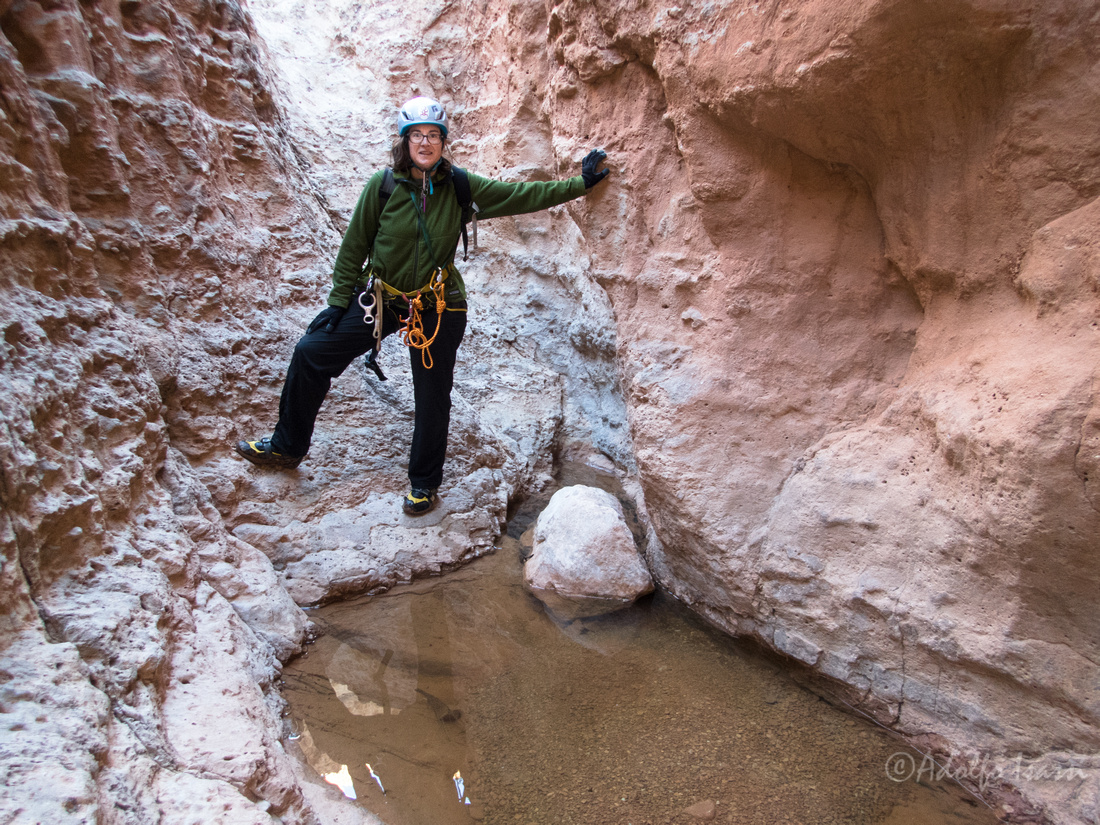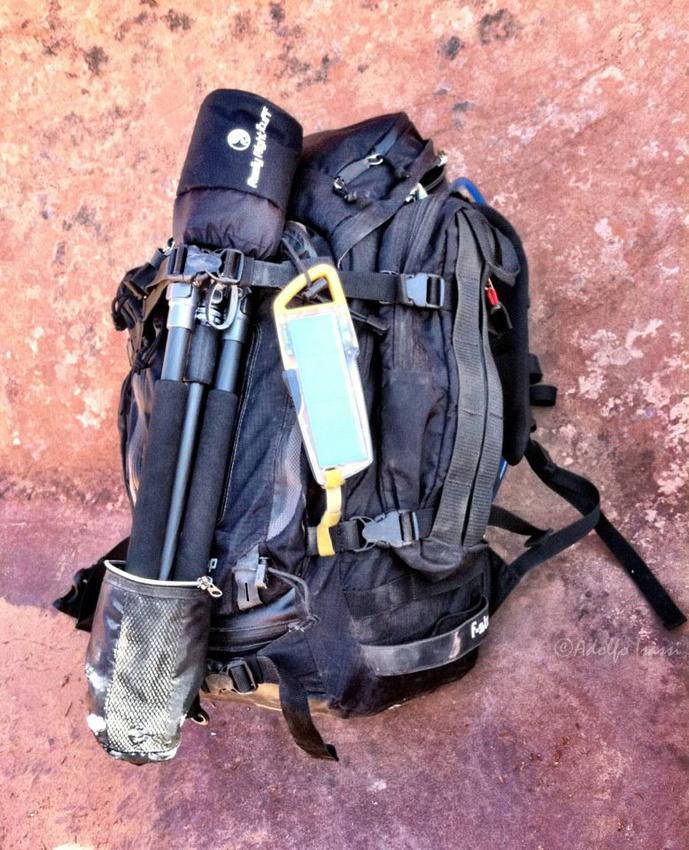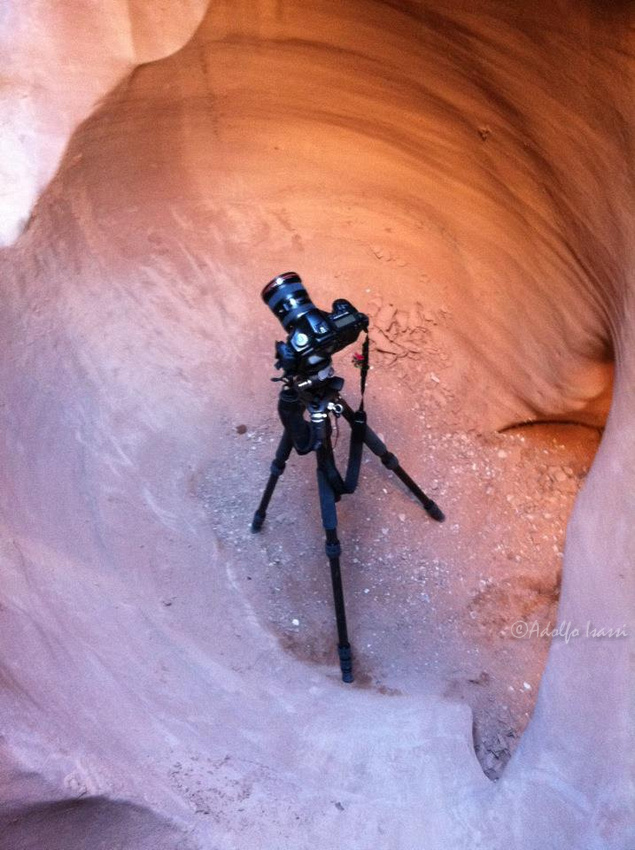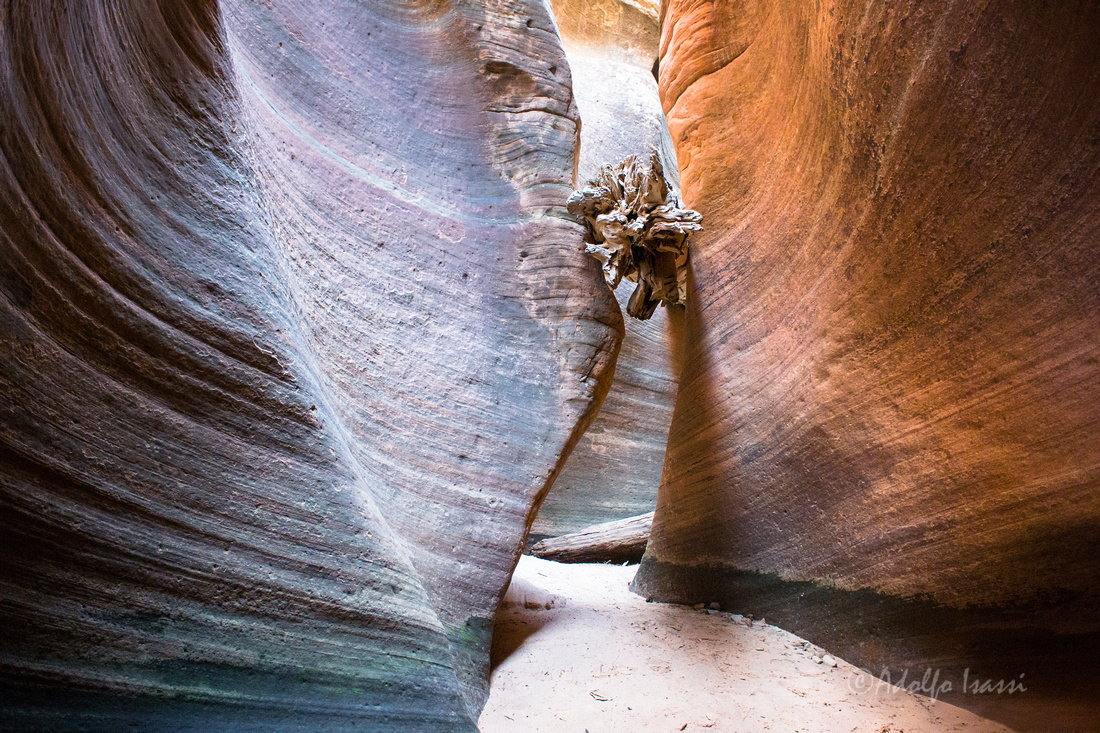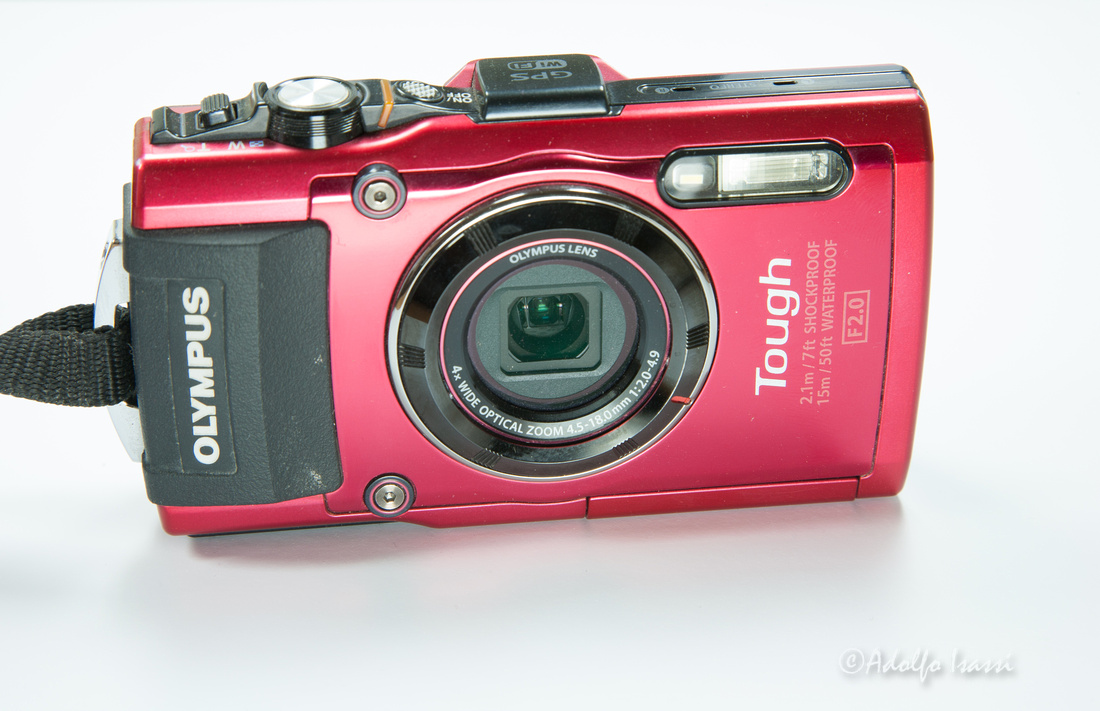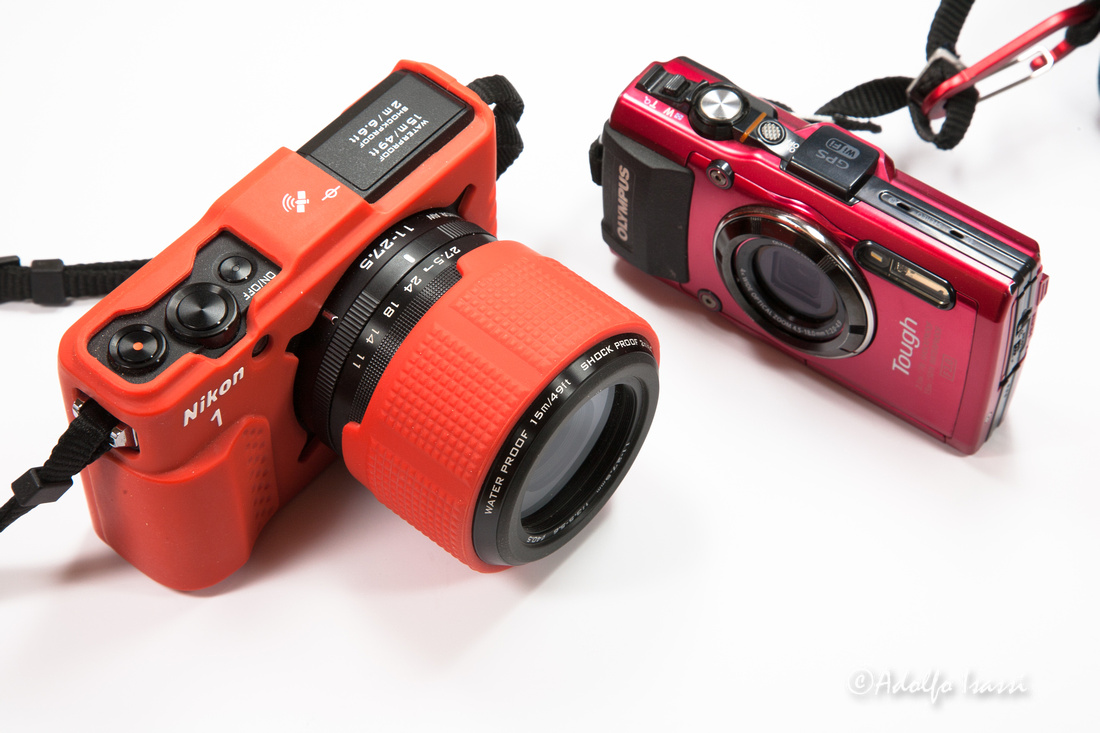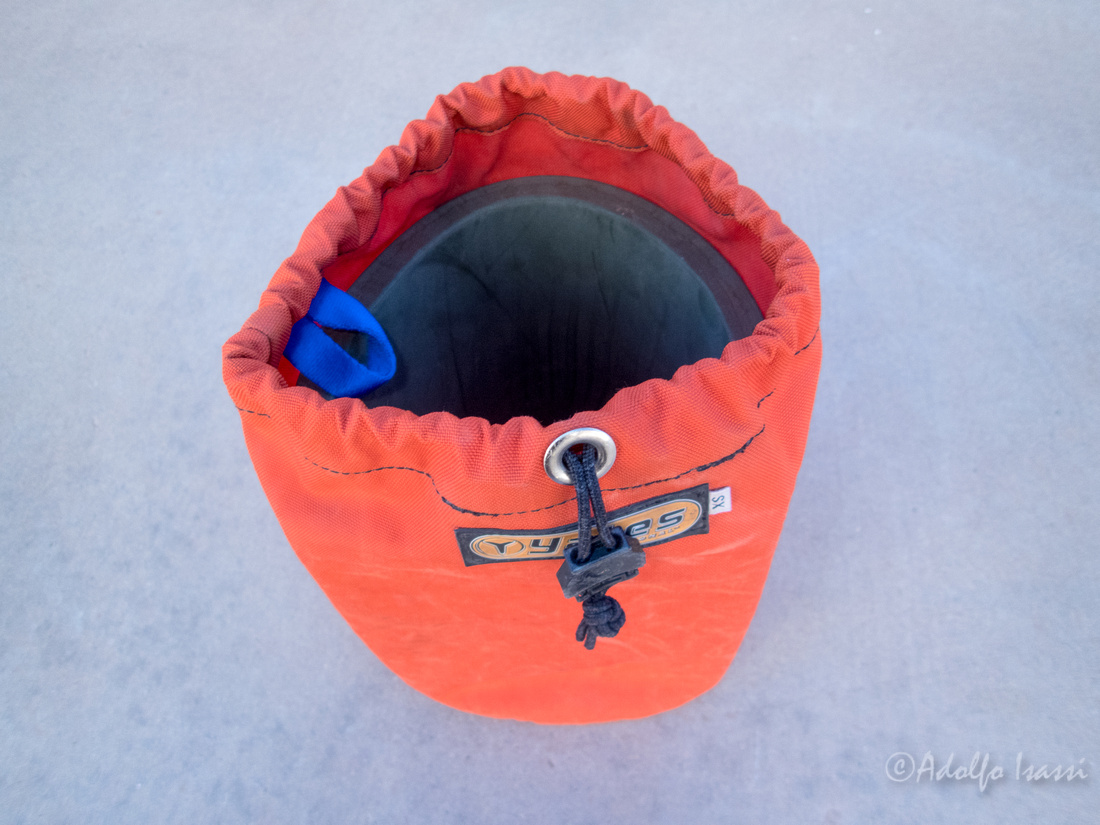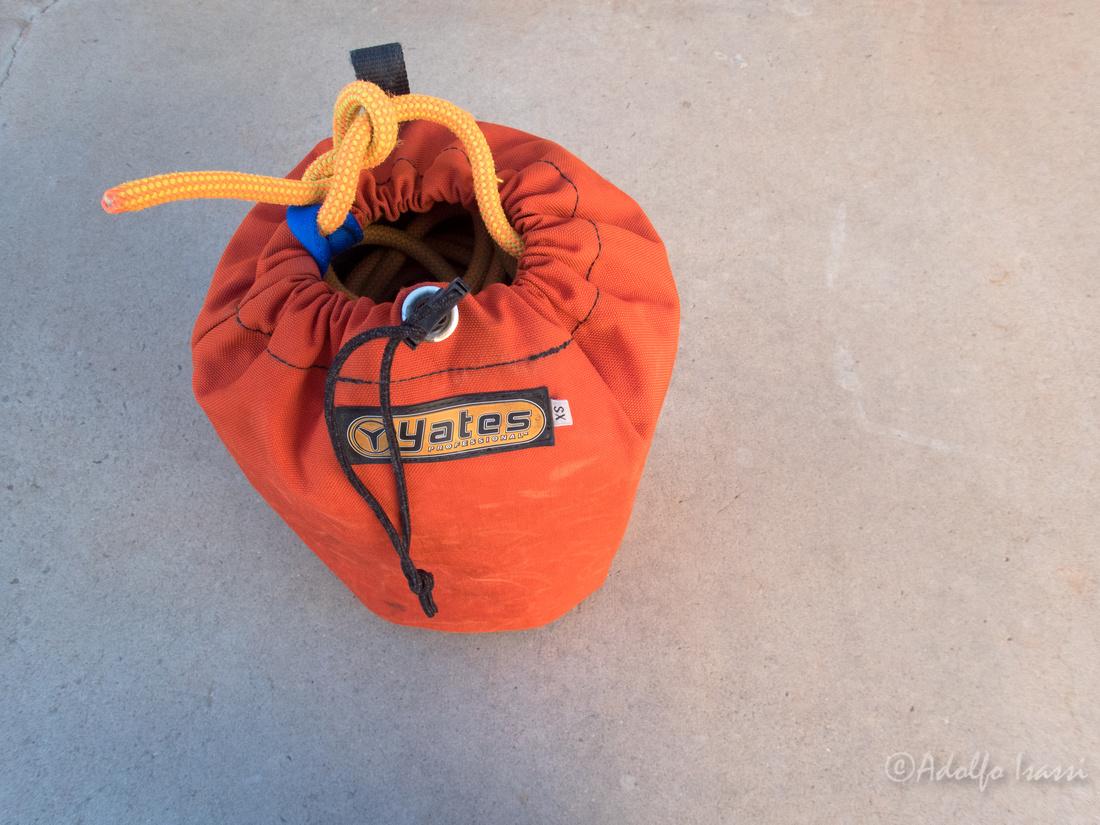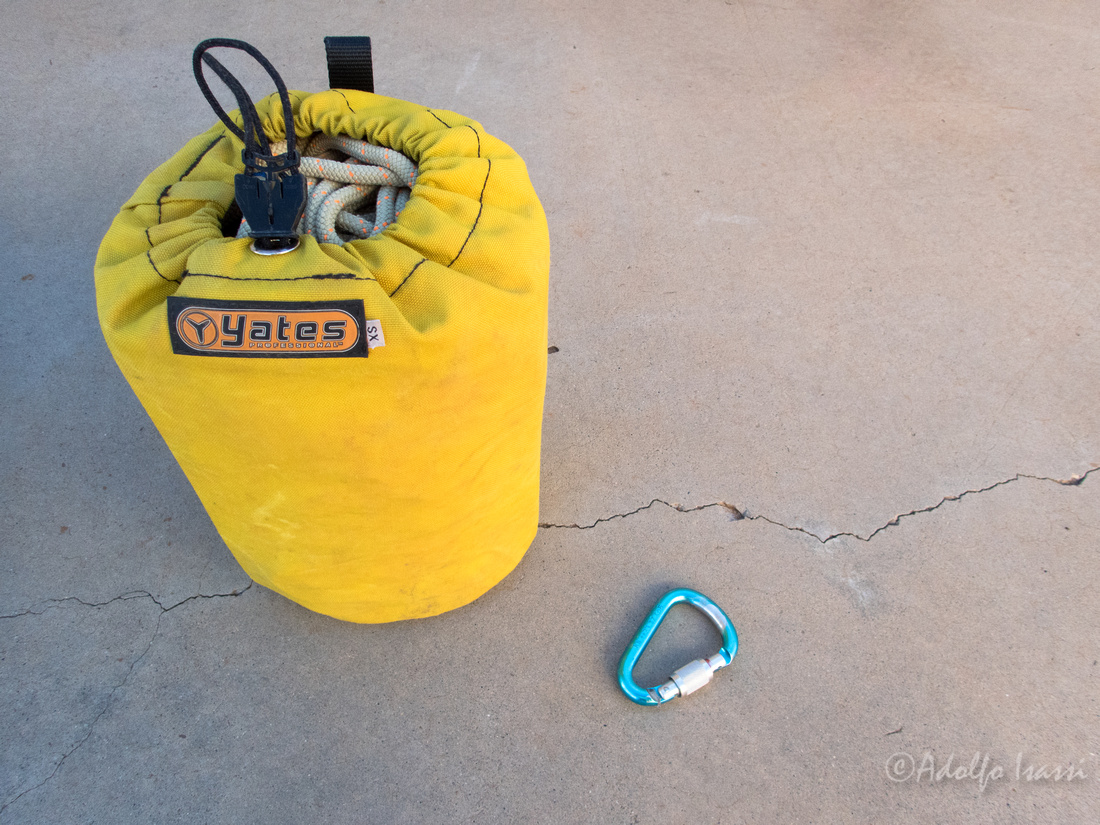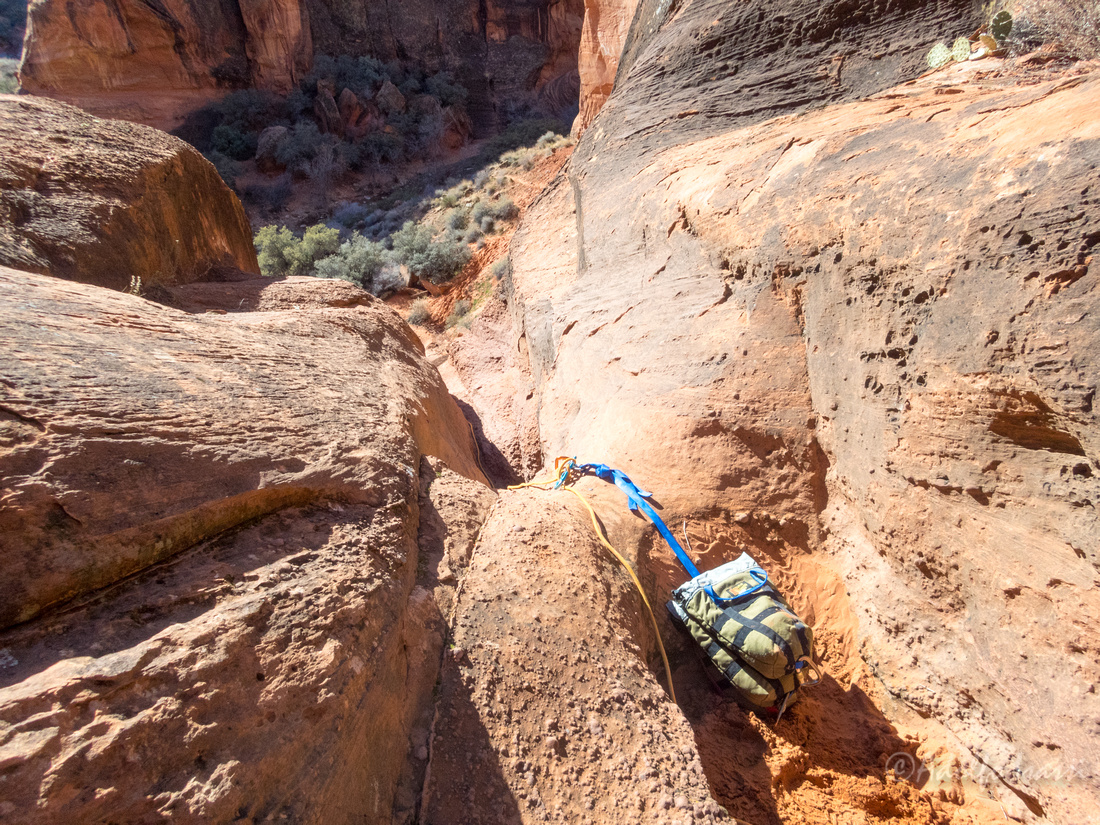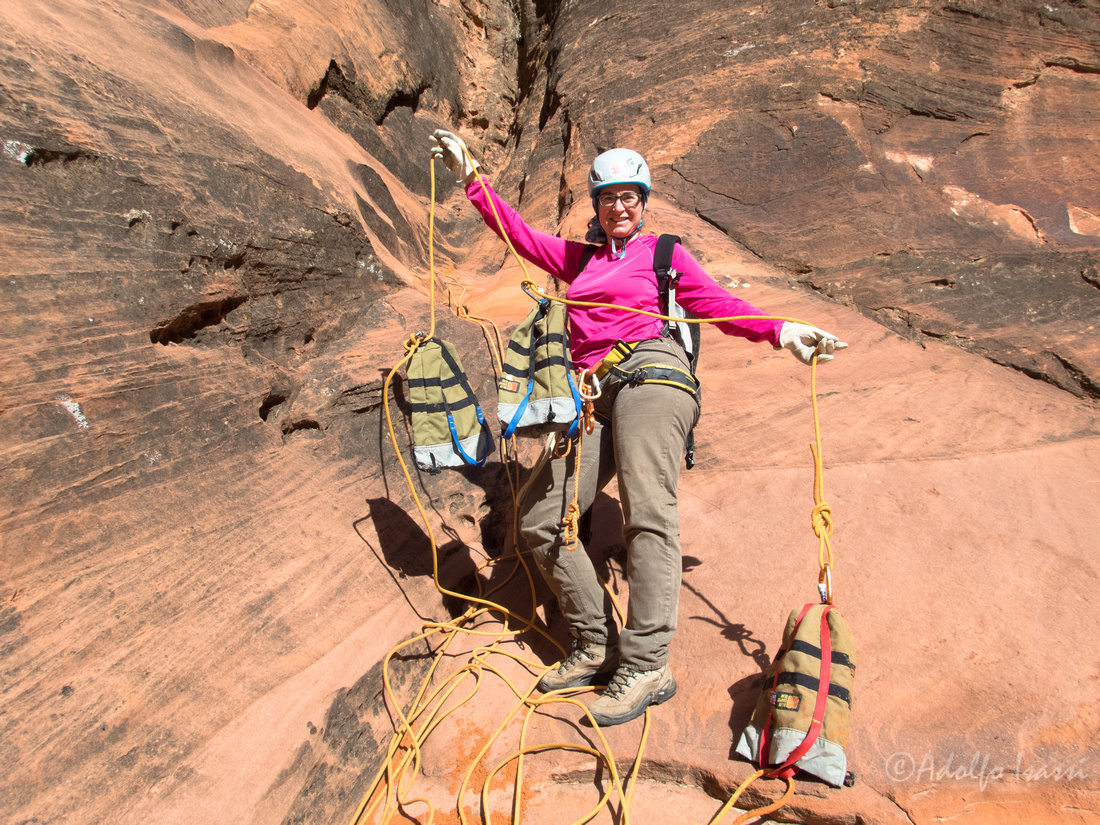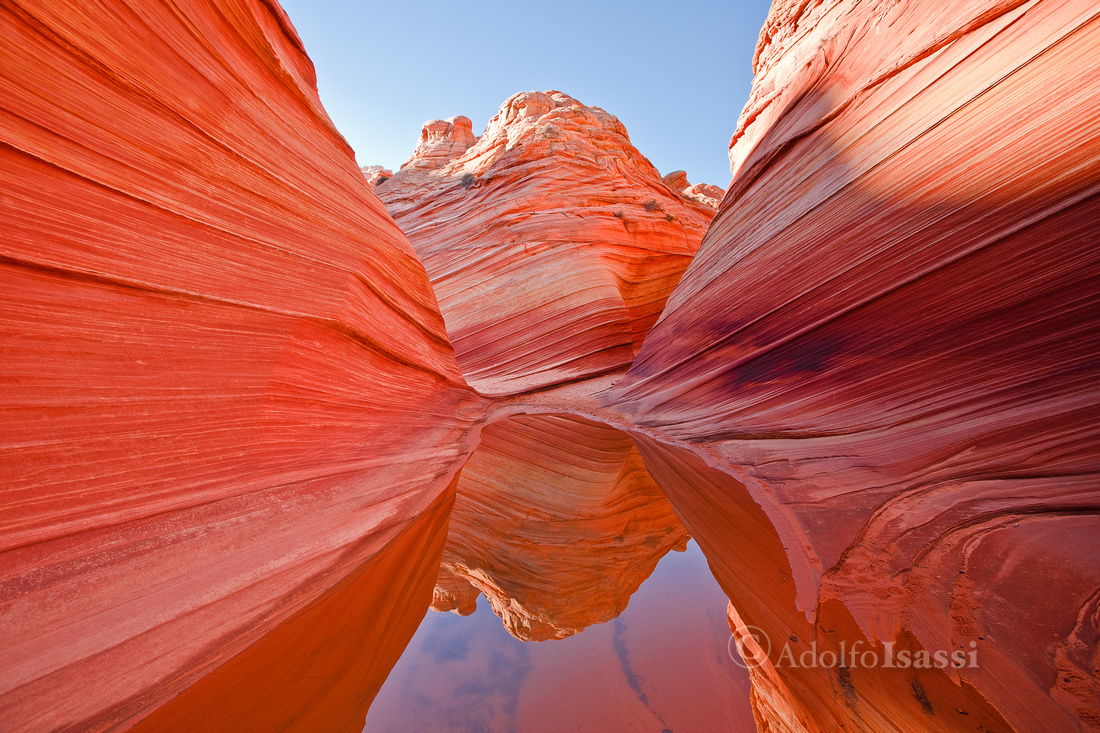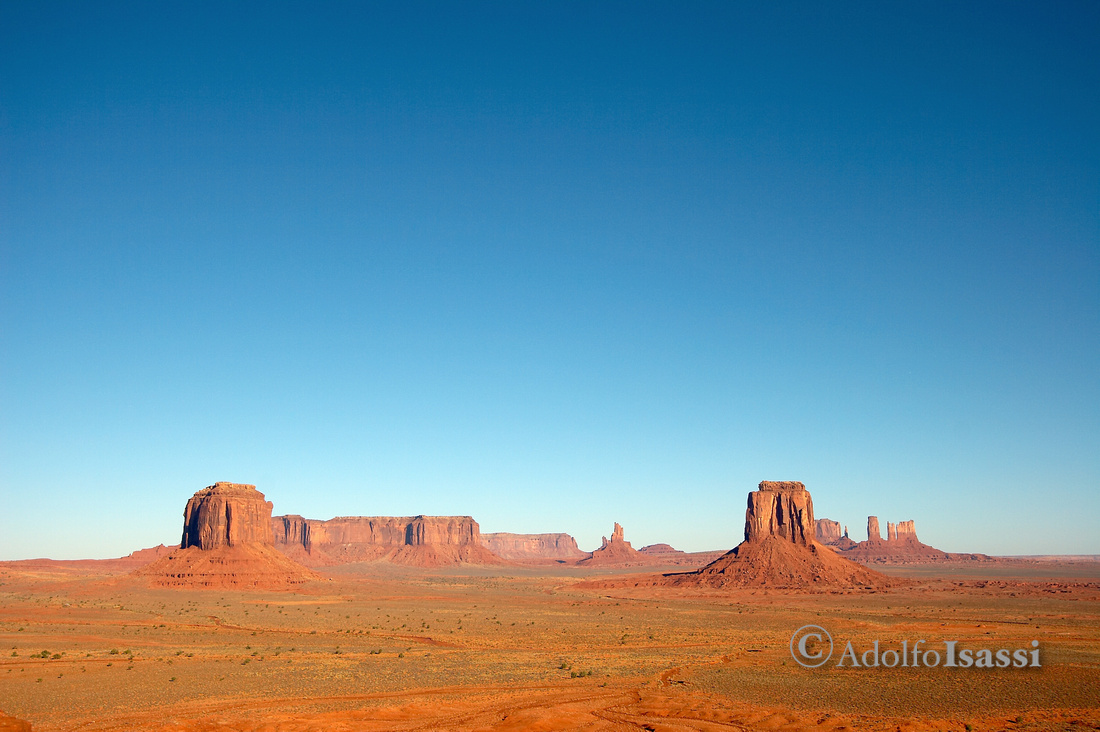Notes on Photography
Staying Dry
The notion of "staying dry" may be a peculiarity of Colorado Plateau canyonering. Canyoneering in other areas around the country and the world, is all about getting wet. Still, walking in wet clothes in Utah winter is no fun, and carrying a wetsuit for a couple of frigid potholes seems overkill. When we saw water at the bottom of the first rap, we knew that, at least one person was going to get wet. So I went down and set up a guided rap to keep Vic dry.

 Second Rap gotcha: More water - Can you spot the potential anchor down there for a guided rap?
Second Rap gotcha: More water - Can you spot the potential anchor down there for a guided rap?
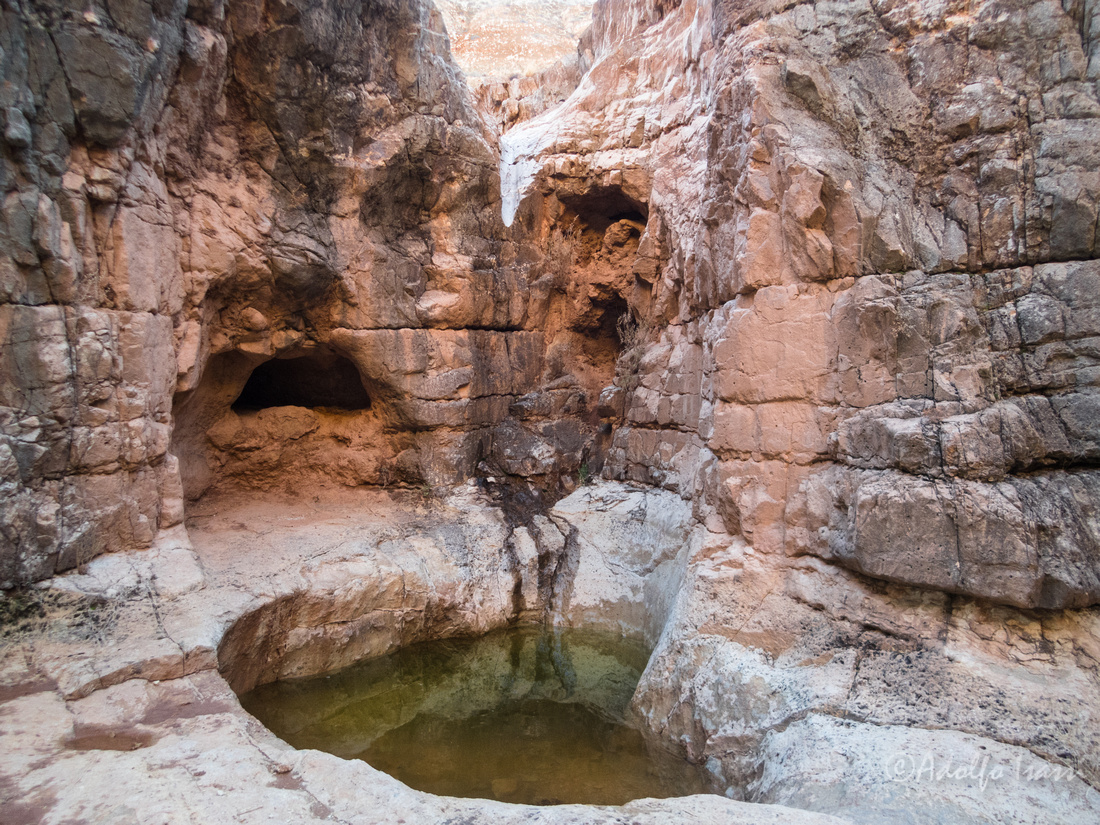
 A pothole, and 3 habitats. 2 birds on the right, and one mammal on the left. Nice neighborhood.
A pothole, and 3 habitats. 2 birds on the right, and one mammal on the left. Nice neighborhood.
Canyoneering Cameras
When I started photographing canyons, I just took my landscape photography gear to task. Canon DSLR bodies and lenses, Gitzo tripods and RSS ball-heads and brackets. Although I experimented with HDR, I never liked it much, so I kept carrying my set of Lee ND Grad filters.
As I got deeper and deeper into canyoneering, it became obvious that I needed to minimize my photo equipment and needed more protection from impact and water. For a while, a small Canon DSLR, with either a 10-22mm EFs or a 17-40mm EF lens in a Mountain Smith photo cube inside a double dry-bag was my "to-go" setup. Sometimes, when logistics permitted, I would take a Gitzo Traveler tripod into the canyon.
Canon bodies and lenses. Gitzo tripods. RSS Heads and brackets. F-Stop bags
Carrying gear deep into canyons
As the canyons got more technical, the approach to photography transitioned to a hybrid of "Landscape Photography" and "Action Photography"....something more in tune with "contextual portraiture". The determining factors shaping the equipment selection are:
- Low light -> Resulting in either:
- Use of tripod -> Resulting in:
- Route logistics become dominated by photo gear limitations.
- High ISO capable camera -> Resulting in:
- Camera needs to offer RAW format to have control over image noise associated with high ISO settings.
- Use of tripod -> Resulting in:
- Water Protection -> Resulting in either:
- DSLR water protection:
- Dry bags -> Resulting in:
- Not very reliable and constant in and out packing.
- Water Housing
- Expensive and bulky. Some cameras overheat inside these housings.
- Hard access to camera settings.
- Dry bags -> Resulting in:
- DSLR water protection:
- Wide angle availability:
- Canyons are narrow. Camera needs to support at least an ideal range of 16mm ~ 24mm.
This worked for a good while, until things became more vertical
For a while, all these factors kept pointing me back to some variation of my current gear, but sometime around 2014, Nikon released the AW1. A waterproof body with inter-changeable lenses, (10mm f/2.8 lens avaialble Nikon CX format) equivalent to ~27mm) high ISO settings and.....able to deliver images in native RAW Nikon format NEF.
Nikon AW1 with 10mm f/2.8 lens
This seemed like the perfect camera for canyoneering. And for a while it was for me. This camera takes beautiful photographs.
AW1 down in Keyhole
But during a photo-session in Keyhole in Zion....the camera developed a water leak. The leak manifested itself in the form of unresponsive buttons in the camera's back panel. Preview, menu, mode...buttons became unresponsive. The camera would turn on and off and take photos, but you could not change any current settings. A closer inspection revealed water inside the battery / memory card compartment. Somehow, water leaked through the back panel. The camera was still under warranty, so I sent it back to Nikon. They repaired the camera and sent it back. It took about 2,3 weeks. It took only about 2 more canyon descents for the repaired camera to fail again in the exact same manner. This time, I asked Nikon to replace the whole camera, no more "repairs". This process took a....long time. I think it was a couple of months for Nikon to inspect the camera and agree to replace it with a new one. All this this gave me ample time to research online and find similar reports of AW1s water leaks.
Olympus TG4
About this time, Olympus announced the release of the TG4. At the time I got my AW1, Olympus only offered the TG3, which had all the required specs, but no RAW shooting. But now, the new TG4 offered Olympus native RAW format ORF. I got the TG4 and it turned out to be a very versatile more agile camera than the AW1, but not without its drawbacks:
- When shooting in RAW format, 4/3 format is not available, only the more squarish 2/3
- The Olympus built in lens, is super prone to chromatic aberrations, i.e purple fringing with counter-light shots.
Still, with the proper knowledge of the TG4's limitations, in the right hands, the camera can deliver stunning photos.
TG4 hand held down a technical beautiful canyon.
TG4 crisp detail and rendering
Nikon finally sent me back a new AW1, and I started to compare the 2 cameras head to head. I like AW1 photos better, both because of the 4/3 format and the crisp, clean quality seems more consistent under almost all conditions.
Nikon AW1 vs. Olympus TG4
So far the new AW1 has not leaked, but I am definitely baby sitting the camera against hard splashes and dirty / muddy water....two factors present in previous failures.
So there you have it. Two cameras to consider for the rough task of canyoneering photography.
Cheapo Bag 2.0 + New cool bags
While taking gear inventory for the new season, I came across my "Cheapo Bags". These Yates bags are cheap, light, compact...but they do not float. In 2014, I had to babysit these non-floating bags in wet canyons. In 2015 I retrofitted these bags with a piece of pipe insulation. This made them float, but in the field, after heavy dunks, the soaked rope overpowered the puny foam pipe. The bag will not sink to the bottom, but there was room for improvement.
Also, the Cheapo bag did not free-stand, which made rope stuffing awkward compared to Imlay or Werks bags. My lovely wife found these gardening pads made out of closed cell foam that are just the perfect size to inject new life into the Cheapo Bags.
Eventually I end up buying some $$ bags that are bulkier, but totally worth it.
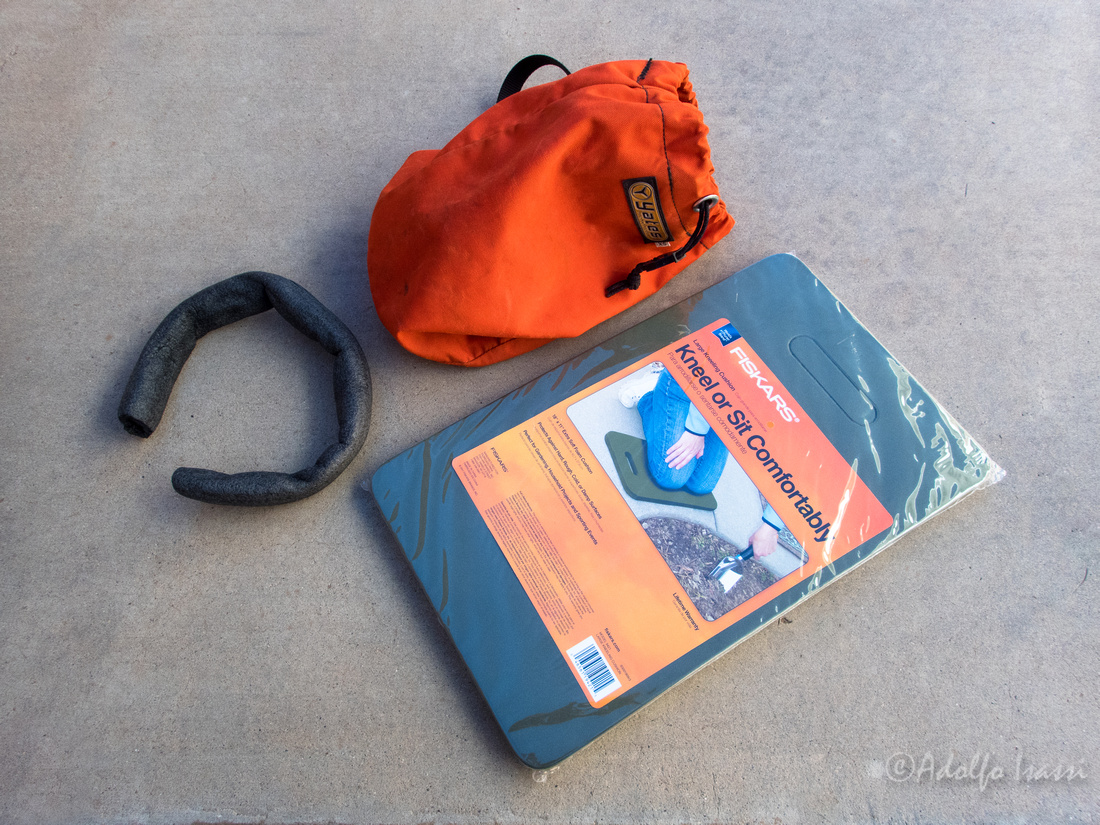
 Replacing the pipe insulation with the chunkier rectangular knee pad
Replacing the pipe insulation with the chunkier rectangular knee pad
Pad inside. Now the bag can free-stand and stay afloat no matter what.
Bag with 120 feet of Imlay Canyon Fire 8.3mm. Perfect fit.
Cheapo XS bag with new floating pad and 200 feet of Blue Water Canyon Pro rope. A bit cramped, but still OK.
Rodcle rope bag. Future home for a 300 feet rope. Very cool bag. Attachment points are both at the top, so you can check if rope is secured to the bag.
Rodcle rope bag can double as a small Mea West Slot canyon bag.
Small Imlay bag hosting 200 of Imlay Canyon Fire 8.3 rope. One cool feature of newer Imlay bags is that you can remove the floating foam if you need a super compact bag.
Potshots as Anchors
This was our little first descent for 2016. It started as a little exploration of one of those...cracks that we see on our way to other canyons: Is that a "Thing"?
We scrambled to the bottom of the first drop. That looks like 60', 70' rappel. Back at home, snooping the area with satellite images and topo maps, the area above did not show much promise. Still we came back with gear to scramble our way to the top, and drop.
We got to the rim and found a way to drop to the wash: Virgin wet sands. We explore and enjoy the area, then we proceed to descend. We look around and there are no signs of slings, bolts, dead-mans....nothing. It's all us, a fresh problem!
Candidates for an anchor: A tree high-up on the rim. Farming a rock into a pothole for a dead (drowned) man. A 30' extended sling around a big friendly boulder. Use a stack of potshots. This was one of those situations where the closer you get to the drop, the anchoring options become slimmer. The tree was too far up and back, our 120' will not do. The long sling felt...dirty, not a clean solution. The deadman required trashing about 30' of canyon fluted walls to reach the intended pothole. So we opted for 3 stacked potshots against a good lip. The only problem was that in front of that lip, there was still another small pothole that could catch the potshots during the pull. And moving the potshots further near the drop, will prevent us from load testing them. After filling the 3 potshots with sand and stacking them, they felt bomber solid. The trick was the pull. So I chained them real far apart.
Potshots stacked against the lip. For the first person down, a sling was used to extend the reach for a releasable block. For LMAR, sling was removed and a double bowline + double fisherman was used to fix the rope to the bottom potshot.
Potshot chain coming down the cliff
Clean potshot chain pull. The trick was to chain the potshots far apart, so each one could clear the potential jam individually.
Story Behind the Photo: Documentation vs. Conservation
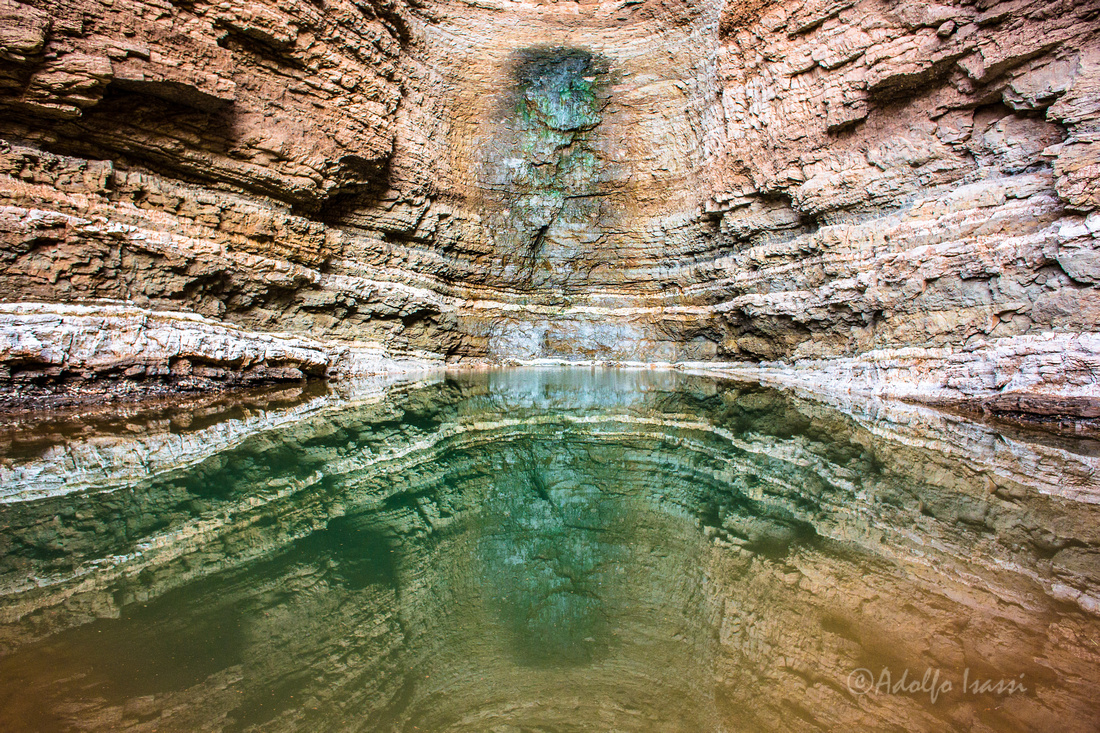
 A canyon in the American Southwest
A canyon in the American Southwest
Documenting landscape shots. Recording the location, date and time of the photograph, along with the, body, lens, film and exposure used to take it. Perhaps some notes about the weather and particular circumstances that affected the execution of the shot.
Through my years of landscape photography, I have slowly updated my documentation practices. Once I switched to digital photography, I used the metadata fields in the file header to store this information. The EXIF standard fields store all the camera and exposure information, and for a while, I had to record manually the location. Now, some of my camera bodies record the GPS location coordinates for every photograph.
A canyon in the American Southwest
While selling prints, I always felt that it was important to provide the date and location of the scene. I would provide this information on the back of the print with an archival rated felt pen. When the era of "internet photography" came through, I noticed though the years a shift on the interest of this information (location) being used to go and take the same photo or photos at that location. Paired with the Internet as a new source of gorgeous photography destinations, I think that digital photography dramatically increased the number of people showing up at these destinations.

 A canyon in the American Southwest
A canyon in the American Southwest
Places like "Oxbow Bend", "Mesa Arch", "Sneak River Overlook", "Zion Virgin Bridge", "Zion Subway", "The Wave" and many others have become stunningly crowded with photographers that often are more concerned with photography than with the preservation of the place. Obviously, as I witness this, I can see that I am part of the problem.
Mesa Arch
Conflicted and without an easy answer, I have been modifying my documentation practices. Although I still retain all the location metadata, I strip it for any posting or publishing, and I no longer reference the specific location in the title. This has been the genesis of "Canyons of The American Southwest" title series, where I acknowledge the beauty of the region and landscape features, but do not provide a waypoint for people to travel and flood the place.
The infamous Wave
I think we live on a time where the combination of overpopulation and outdated notions of land usage are conspiring to degrade wilderness in general. Not sure at this point if photography will be critical to preserve some record before wilderness becomes an amusement park of sorts, or photography is a critical contributor to pave this path.
The American Southwest

